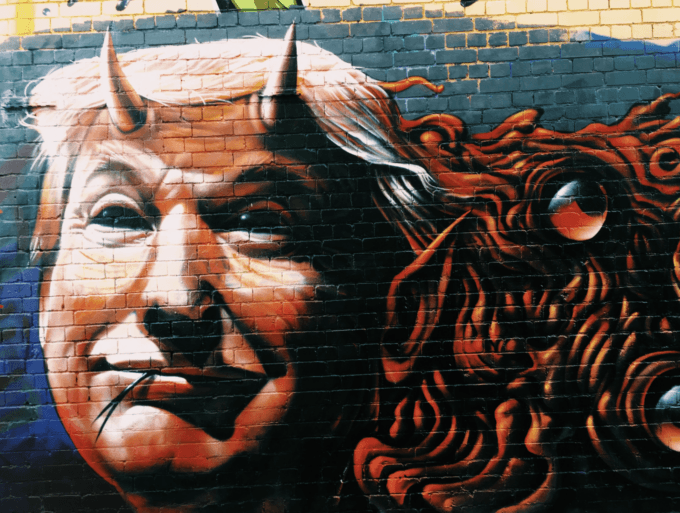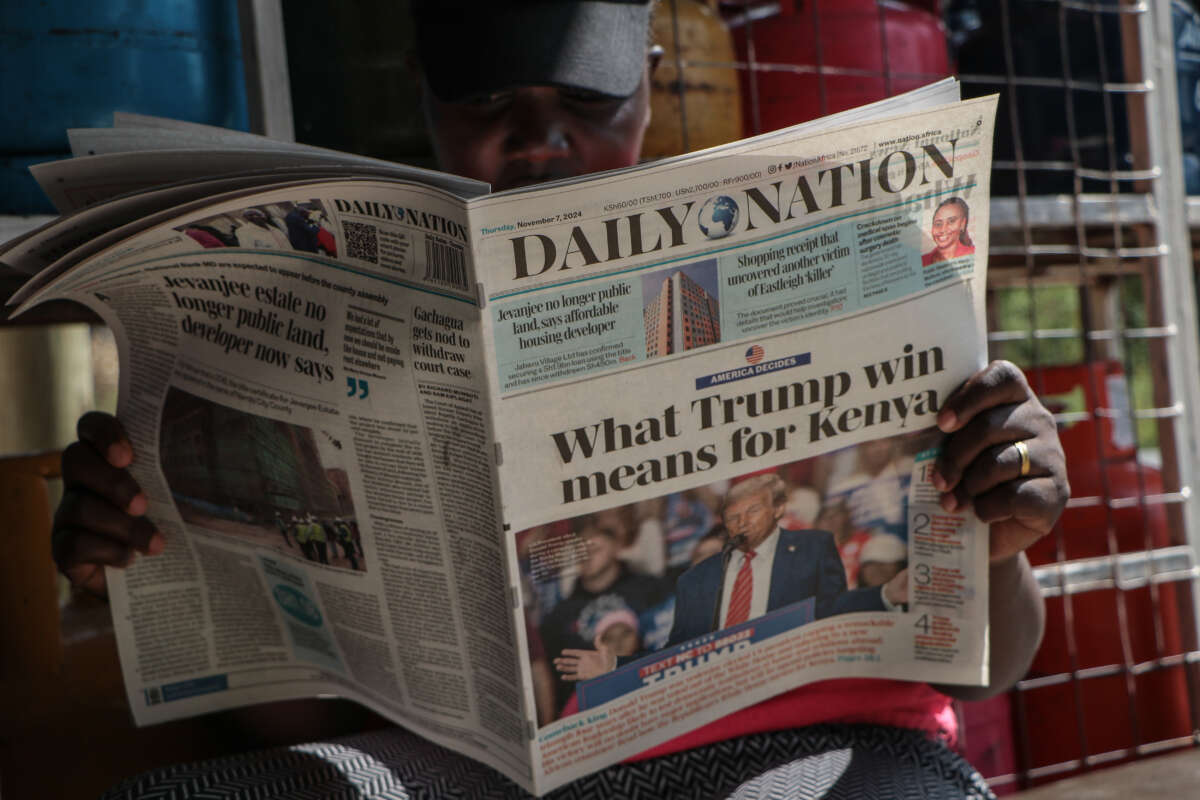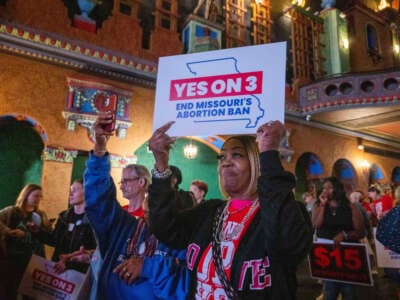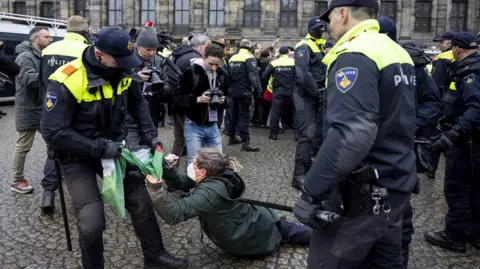A New Wave of Movements Against Trumpism Is Coming
Our job is to translate outrage over his agenda into action toward a truly transformational vision.

The Protect Our Futures march in New York City on Nov. 9.
For many of us, the immediate aftermath of Donald Trump’s decisive electoral victory has been a time of deep despair and mourning. There has been plenty of commentary trying to make sense of Trump’s win and the factors that led to it. But no analysis changes the fact that the outcome represents a serious blow to our most vulnerable communities, a sharp setback for causes of economic and social justice, and a profound challenge to whatever semblance of democracy America has been able to secure. We have lived through it before, and it feels even worse the second time around. It is right that we take this as a moment to grieve.
But even amidst our feelings of sorrow or hopelessness, we can recognize that political conditions are not static. As we step out of our grieving and look ahead, there are reasons to believe that a new social movement cycle to confront Trumpism can emerge. And in making this happen, we can draw on lessons from what has worked in the past and what we know can be effective in confronting autocrats. Our job will be to take advantage of the moments of opportunity that arise in coming months to hold the line against Trump’s authoritarianism — and also link them to a vision for creating the transformative change we need in our world.
Here’s why we can expect a new wave of movements to arise.
Trump is a trigger
We have often written about the importance of “trigger events” in sparking periods of mass protest. Social movement organizers can labor for years in relative quiet, carrying out the long-term “spadework” — as civil rights icon Ella Baker called it — of consciousness raising, leadership development and building organizational structure. But there are also moments when issues of social and economic injustice are thrown into the spotlight by a dramatic or expected public event: A shocking scandal, a natural disaster, a geopolitical conflict or an investigative report revealing gross misconduct stokes widespread outrage and sends people into the streets.
In 2016, Trump’s election itself served as a trigger event. A wide range of groups, from the liberal ACLU to the more radical Democratic Socialists of America, saw membership and donations surge as concerned progressives braced for what was expected to come from his administration. New groups also emerged, such as Indivisible, which began as a viral Google Doc about how to confront elected officials and compel them to resist the Trump administration. It then quickly grew into an organization with more than 4,000 affiliated local groups by 2021.
At the same time, outrage among women about Trump being able to take office in spite of his overt misogyny led them to mobilize in record-breaking numbers. A call to action went out immediately after the election, and on January 21, 2017, the day after Trump’s inauguration, upwards of four million people rallied in Women’s March events, spread across every state in the nation. Scholars tracking participation identified this as “likely the largest single-day demonstration in recorded U.S. history.”
This time around, the mood is different. The shock of “how could this ever happen” that many experienced eight years ago feels distinct from the gut-churning sense of “it is happening again” that is sinking in this time around. As the New York Times described it, there is a “stunned, quiet and somber feeling,” sometimes accompanied by resignation, rather than an immediate impulse to rise up in resistance. That said, established progressive groups that have created space for members to gather to make sense of the electoral outcome and plan a response have seen a strong response. Most notably, a mass call two days after the election organized by a coalition of 200 groups — including the Working Families Party, MoveOn, United We Dream and Movement for Black Lives Action — drew well in excess of 100,000 people, with thousands signing up for follow-up community gatherings.
There is no better antidote to hopelessness than action in community.
There will be more opportunities to come. It is highly likely that future trigger events will arise as Trump begins implementing his agenda. Although he won a commanding electoral victory, a significant portion of his gains can be attributed to rejection of the status quo and a desire on the part of voters to sweep out a broken political establishment. On a policy level, Trump is often incoherent. Although he presents himself as a champion of those left behind, he cannot deliver for working people. Instead, many of the things that he will attempt may prove to be deeply unpopular, from tax cuts for the wealthy and attacks on women’s rights, to unconstitutional power grabs and cuts to social services or public benefits.
Should Trump begin to carry out the program of mass deportations that he has promised, resulting in separated families and shattered communities, conservatives could quickly find that their overreach has sparked backlash and defiance — not only from defenders of human rights but even from business people alarmed at the economic disruption.
In late 2005, when the Republican majority in the House pushed through a piece of anti-immigrant legislation known as the Sensenbrenner Bill — a measure which, among other impacts, would have created penalties for providing humanitarian services to undocumented immigrants — it gave rise to a series of massive immigrant rights protests in the months that followed. Hundreds of thousands marched in 2006, not only filling the downtowns of major cities like Chicago, Dallas and Los Angeles, but also flooding public squares in places such as Fresno, Omaha and Garden City, Kansas. These actions galvanized the Latino vote and had lasting impacts in multiple election cycles that followed.
Likewise, in the early days of Trump’s first term, his administration’s “Muslim ban” prompted rallies and civil disobedience at airports around the country. While the ban was being challenged in court, the actions served as major public flashpoints, both bolstering local groups and giving rise to national formations such as #NeverAgainAction, while also prompting cities to make vows to protect migrants.
Public revolt can cut both ways: The rise of the Tea Party in 2009 became a significant hindrance to Barack Obama’s ability to pursue a progressive economic agenda. But whether such mobilizations come from the left or right, it is important to recognize that they can have significant consequences.
Activism during Trump’s first term was able to create a sense of an administration that was embattled and mired in controversy, rather than one carrying out a popular mandate. While most presidents can expect to enjoy a bump in popularity following their inaugurations, Trump instead faced record-low approval ratings. And while conservatives passed a major tax law that favored the rich, they were unable to realize other top goals such as the repeal of Obamacare. With the 2018 midterms, movements played a significant role in creating one of the most dramatic swings in recent electoral history, propelling a wave that both swept Democrats into power in many states and deprived Republicans of control of the U.S. Congress, closing their window of maximum legislative power.
Looking forward, Trump will trigger outrage. But outrage alone is not enough. It needs to be translated into action. Movements must be ready to capitalize on and extend the opportunities that Trump’s policies create. Here, preparation is helpful: By anticipating and planning for trigger events, movements can position themselves to take maximum advantage.
Different strategies for change can work together
When we track the impacts of mass protests, one of the most consistent things that we witness is that critics are eager to denounce activist tactics and preemptively declare new movements as ineffectual, even when they have scarcely just appeared. When mass protests erupted in Trump’s first term, there were a plethora of voices condemning them as pointless and even counterproductive.
In the New York Times, David Brooks conceded that the Women’s March was an “important cultural moment,” but argued that “Marching is a seductive substitute for action,” and that it ultimately amounted to little more than “mass therapy” for participants. “Change happens when people run for office, amass coalitions of interest groups, engage in the messy practice of politics,” Brooks wrote, contending that “these marches can never be an effective opposition to Donald Trump.” Such pessimism was sometimes echoed by left-wing commentators as well, who devoted more energy to dissecting the political limitations of the Women’s March than capitalizing on the opportunities it created to draw new people into long-term organizing campaigns.
In fact, people newly activated by the march became part of many subsequent efforts, and the following year the mobilization fed directly into the #MeToo movement, which erupted after another trigger event — namely, publicity that shed light on the sexual abuses perpetrated by Hollywood mogul Harvey Weinstein. Not only did #MeToo have far-reaching implications for policy, in the legal system, and in other arenas of public life, it also significantly affected voting patterns, with the Washington Post reporting on a “women-led army” that was “repulsed by Trump and determined to do something about it” driving abnormally high turnout in 2018 and 2020.
But the even bigger problem for the argument of those who dismiss mass protest is the assumption that different approaches to creating change are mutually exclusive. To the contrary, key to both defeating Trumpism and winning what we actually want in the future is cultivating a healthy social movement ecosystem in which multiple approaches to change complement and play off one another. There is strong evidence from past mobilizations that mass protest in fact feeds such an ecology in many different ways. Following peak periods of unrest, which we describe as “moments of the whirlwind,” those who have been laboring for years in the trenches often remark on how the surge of interest and support significantly expands their horizon of possibility.
Social movements alone have the potential to produce a response to Trump that both invites mass participation and that is connected to a broader vision for change. The alternative — relying on legal cases or other insider challenges to the administration’s policies, hoping that politicians will save us, or relying on Democrats, by themselves, to not cave or conciliate themselves to Trumpism — is a recipe for defeat and demobilization.
The bright spots of the first Trump era came as movements not only rallied large numbers of people in defensive battles against the White House, but also carried forward popular energy by organizing around a positive vision for change. Here, the model offered by Bernie Sanders was very important. Sanders achieved far greater success in his 2016 primary challenge to Hillary Clinton than anyone in the Washington establishment could have imagined by running on a resolute platform of Medicare for All, free higher education, and confronting the power of corporations and the rich. Whether or not “Bernie would’ve won” in 2016 had he been in the general election, as many of his supporters believe, the senator was nevertheless vital in pointing to a model of how Trumpism could be combated with a progressive populist vision, rather than a retreat to the center and the adoption of “Republican-lite” versions of policy.
Groups motivated to build active support for such a vision — which included progressive unions, community organizations investing in electoral work in a more concerted way than ever before, and new or re-energized formations such as the Democratic Socialists of America, Justice Democrats, Our Revolution, the Working Families Party and the Poor People’s Campaign — entered into contests that gave rise to the Squad at the federal level, as well as an unprecedented number of movement champions taking office locally.
The Sunrise Movement, another group that contributed to this push, exploded onto the scene in 2018, playing a key role in putting the Green New Deal at the center of policy debate and, along with Fridays for Future, revitalizing climate activism. Trigger events around police violence ignited a new round of Black Lives Matter protests and a national reckoning on race that has helped secure important gains around criminal justice reform — strides toward which have continued in spite of backlash.
This time around, we must be more clear than ever that our goal is to win over a majority of Americans. Movements should not be afraid to engage in polarizing protest, but they should be mindful of the challenge of producing positive polarization that reaches out to include more people in the fight for justice, while minimizing negative polarization that pushes away potential supporters. Crucial to this is always seeking to expand the coalition of allies, engage in political education to bring in newcomers, and not accept the myth of the righteous few, or the idea that the path to victory is through demanding ever-greater levels of moral purity among those we associate with, even if that means ever-greater insularity.
The day after the election, Sunrise tweeted: “Trump loves corporations even more than Democrats do, but he ran an anti-establishment campaign that gave an answer to people’s desire for change.” As social movements respond to outrage over Trump’s policies and tie their actions to a real agenda for transformative change, they puncture the pretense that he offers any sort of real alternative to a democracy ruled by elites and an economy designed to serve the wealthy. “We can stop him, and we must,” Sunrise added. “But it’s going to take many thousands of people taking to the streets and preparing to strike. And it’s going to take mass movements putting out a better vision for our country than Trumpism and proving that we can make it happen.”
If ever there was a time to allow ourselves a space for mourning as we contemplate the fate of our country, it is now. But ultimately, only we can save ourselves from despair. David Brooks intended to be dismissive in characterizing collective protest as “mass therapy,” but in one respect he is onto something: There is no better antidote to hopelessness than action in community.
Our past experience tells us that coming months and years will offer moments that trigger public revulsion. Social movements provide a unique mechanism for responding, creating common identity and purpose between strangers and allowing genuine, collective participation in building a better democracy. If we are to make it together through Trump’s second presidency and emerge in its aftermath to create the world we need, this may be our greatest hope. Indeed, it may be our only one.
Mark Engler is a writer based in Philadelphia, an editorial board member at Dissent, and co-author of “This Is An Uprising: How Nonviolent Revolt Is Shaping the Twenty-first Century” (Nation Books). He can be reached via the website www.DemocracyUprising.com.
Paul Engler is the director of the Center for the Working Poor in Los Angeles, and a co-founder of the Momentum Training, and co-author, with Mark Engler, of “This Is An Uprising.”
© Waging Nonviolence. Waging Nonviolence content falls under a Creative Commons Attribution 4.0 International License.
Mark Engler is a writer based in Philadelphia, an editorial board member at Dissent, and co-author of "This Is An Uprising: How Nonviolent Revolt Is Shaping the Twenty-first Century" (Nation Books). He can be reached via the website www.DemocracyUprising.com.
America’s Descent Into Fascism Can Be Stopped

Photo by Jon Tyson
The election of Trump is more than a political event; it is an attempt to legitimize a brutal evolution of fascism in America. His rise is not accidental but symptomatic, emerging from the depths of collective fear, dread, and anxiety stoked by a savage form of gangster capitalism—neoliberalism—that thrives on division and despair. This climate, steeped in a culture of hate, misogyny, and racism, has given life to Trump’s authoritarian appeal, drowning out the warning signs of past and present tyranny.
While it’s clear that American society changed dramatically with Reagan’s election and the corrupt rise of the billionaire elite, we must also recognize how liberals and the Democratic Party, instead of resisting, aligned with Wall Street power brokers like Goldman Sachs. In doing so, they adopted elements of neoliberalism that crushed the working class, intensified the class and racial divide, accelerated staggering levels of inequality, and intensified the long legacy of nativism, all of which fed into the conditions for Trump’s appeal. Clinton’s racially charged criminalizing policies, Obama’s centrist neoliberalism and unyielding support for the financial elite, and Biden’s death-driven support for genocide in Gaza have contributed to a culture ripe for authoritarianism. In short, this groundwork didn’t just make Trump possible; it made him inevitable.
But perhaps one of the most overlooked failures of liberalism and Third Way democrats, and even parts of the left, was the neglect of education as a form of critical and civic literacy and the role it plays in raising mass consciousness and fostering an energized collective movement. This failure wasn’t just about policy but, as Pierre Bourdieu observed, about forgetting that domination operates not only through economic structures but also through beliefs and cultural persuasion. Trump and his engineers of hate and revenge have not only rewritten history but obliterated historical consciousness as fundamental element of civic education. Historical amnesia has always provided a cover for America’s long-standing racism, nativism, disavowal of women’s right. Capitalizing on far right propaganda machines, Trump managed, as Ruth Ben-Ghiat notes, to convince millions of Americans that they “simply could not accept the idea of a non-White and female president.” Nor could they insert themselves in a history of collective struggle, resistance, and the fight for a better world. He also convinced the majority of Americans that it is okay elect a white supremacist to be the President of the University.
Bernie Sanders rightly observes on X that “It comes as no great surprise that a Democratic Party which has abandoned working-class people would find that the working class has abandoned them.” Of course, the Democratic Party shares with mainstream media stenographers the fact that they have refused to forcefully acknowledge, as Sherrilyn Ifill points out, that not only the MAGA crowd but also “a majority of white Americans in fact have chosen to embrace white supremacy rather than the promise of a multi-racial democracy.” Sanders’ comments only scratch the surface. The issue of abandonment and moral collapse also extends to the pedagogical realm: for decades, the right has wielded the educational force of culture to persuade white, Latino, and Black workers to turn their backs on their own interests, binding them to an authoritarian cult and white supremacist ideology that exploits their alienation and sabotages any sense of critical agency. Since the 1970s, galvanized by the Powell Memo, reactionary conservatives have grasped, far more than the left, the transformative power of ideas. They have weaponized culture to dismantle institutions that once nurtured critical thought, education, and resistance. Recognizing that reshaping public consciousness was essential to their agenda, they systematically eroded critical literacy, attacked public spaces, and transformed public and higher education from forces of liberation —turning them into either sites of repression and training or more disdainfully, full scale sites of indoctrination. This was no accident; it was a core part of their long-term strategy—to strip society of its capacity for dissent, molding a populace more easily controlled, more willingly complicit in its own subjugation.
Trump is the grim culmination of this cultural war against reason, truth, and critical thinking. Mass ignorance and civic illiteracy have become not mere byproducts but the very engines of a strategy to blind working people and those considered expendable to the economic injustices ravaging their lives. Rather than addressing these economic onslaughts, they are instead lured into a communal theater of hate and bigotry. This spectacle of manufactured ignorance and call for cult-like loyalty does more than cloud the mind; it becomes a political weapon, rendering the dispossessed both docile and divided. Neoliberal ideology intensifies this dynamic, imprisoning people in suffocating bubbles of self-interest and hyper-individualism. It wages a calculated assault on collective solidarity, designed to transform the public into isolated consumers, unable to envision a politics beyond their private lives or recognize that their true power lies in unity and critical consciousness. At the same time, it takes advantage of the anxiety and loneliness experience by the disposed to lure them into a false community of hatred and lawlessness. The need for solidary falls prey under Trump into the lure of what Ernst Bloch in The Principle of Hope called the swindle of fulfillment.
With no viable movement for meaningful social change in sight, Trump and his modern-day Brownshirts exploited the void left by a crisis of consciousness. Into this gap, they injected a corporate-controlled culture that shaped daily life with a culture steeped in hatred, fear, anxiety, and the force of endless fascist like spectacles. It is worth noting that such spectacles are chillingly reminiscent of Nuremberg in the 1930s, designed to stoke division and obedience, distracting the public from any path toward collective resistance or liberation. This carnival of divisiveness and dehumanizing rhetoric did more than destroy the nation’s civic and educational fabric, it produced a poisonous populist culture that changed the way most Americans view the past, present, and future.
If we are to confront this fascistic momentum, we must urgently return to the tools necessary to rebuild a mass consciousness as a precondition for a mass movement–one that can use the mobilization of mass consciousness, strikes and other forms of direct action to prevent this new fascist regime from governing. We need to stop this machinery of death from enacting the enormous suffering, misery, violence, and power that gives it both a sense of pleasure and reason for enduring.
With Trump’s rise to power, American citizens have empowered a fascist agenda—one bent on enriching the ultra-wealthy, gutting the welfare state, deporting millions, and dismantling the very institutions that uphold accountability, critical thought, and democracy itself. These structures are not just formalities; they are the lifeblood of a radical, inclusive democracy and the safeguard for an informed citizenry. In this perilous moment, Seyla Benhabib, drawing on Adorno and Arendt, confronts us with a question of profound urgency: “What does it mean to go on thinking?” Her call to “learn to think anew” resounds with particular force as we grapple with the stark reality of Trump’s election.
We are now compelled to rethink the very foundations of culture, politics, power, struggle, and education. The stakes are clear. In mere weeks, as Will Bunch notes, a man who attempted to overturn an election—who espouses overt racism, embraces white supremacy, and boasts about his rancid misogyny, has pledged mass deportations, and threatens military force against political opponents—will once again assume power. This is a historical crossroads that demands a radical reevaluation of our democratic commitments and strategies for real social and economic change.
Chris Hedges aptly warns that “the American dream has become an American nightmare [and that] Donald Trump is a symptom of our diseased society. He is not its cause. He is what is vomited up out of decay.” Trump embodies the cumulative effects of decades of moral and social corrosion. His presidency signals not a departure but an intensification of a deep-seated national crisis.
In this historical moment, we face an urgent challenge to confront and dismantle the forces entrenching fascist politics and authoritarian governance. Now is the moment to radically transform our approach to theory, education, and the liberatory power of learning—tools we must wield to build a robust, multi-racial working-class movement that is unapologetically anti-capitalist and unwaveringly democratic. We must relinquish the myth of American exceptionalism and the dangerous illusion that democracy and capitalism are synonymous. The cost of inaction is dire: a future where democracy is not merely eroded but supplanted by a violent police state,—a betrayal soaked in blood, extinguishing the dream of a society committed to the promise and ideals of justice and equality.
The stakes could not be higher. We must confront this moment with uncompromising purpose, a blueprint for bold action, and an unyielding commitment to a radical democracy that defies fascist cruelty, bigotry, and the stranglehold of the financial elite at every step. Our future demands it, as does the vision of a society where justice, solidarity, and human dignity are not just ideals but realities—part of a future that defies the rising shadow of fascism threatening to consume us. We either fight to reclaim this promise, or we surrender to a darkness from which there is no return.
Henry A. Giroux currently holds the McMaster University Chair for Scholarship in the Public Interest in the English and Cultural Studies Department and is the Paulo Freire Distinguished Scholar in Critical Pedagogy. His most recent books include: The Terror of the Unforeseen (Los Angeles Review of books, 2019), On Critical Pedagogy, 2nd edition (Bloomsbury, 2020); Race, Politics, and Pandemic Pedagogy: Education in a Time of Crisis (Bloomsbury 2021); Pedagogy of Resistance: Against Manufactured Ignorance (Bloomsbury 2022) and Insurrections: Education in the Age of Counter-Revolutionary Politics (Bloomsbury, 2023), and coauthored with Anthony DiMaggio, Fascism on Trial: Education and the Possibility of Democracy (Bloomsbury, 2025). Giroux is also a member of Truthout’s board of directors.









 China’s Commerce Minister Wang Wentao raised ‘serious concerns’ with his US counterpart Gina Raimondo on Washington’s curbs on its trade – Copyright AFP Pedro Pardo
China’s Commerce Minister Wang Wentao raised ‘serious concerns’ with his US counterpart Gina Raimondo on Washington’s curbs on its trade – Copyright AFP Pedro Pardo





